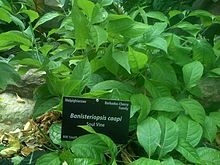| Banisteriopsis caapi | |
|---|---|

| |
| Young B. caapi | |
| Scientific classification | |
| Kingdom: | Plantae |
| Clade: | Tracheophytes |
| Clade: | Angiosperms |
| Clade: | Eudicots |
| Clade: | Rosids |
| Order: | Malpighiales |
| Family: | Malpighiaceae |
| Genus: | Banisteriopsis |
| Species: | B. caapi
|
| Binomial name | |
| Banisteriopsis caapi | |
| Synonyms[2] | |
|
List
| |
Banisteriopsis caapi, also known as, caapi, soul vine, yagé (yage), or ayahuasca, the latter of which also refers to the psychedelic decoction made with the vine and a plant source of dimethyltryptamine, is a South American liana of the family Malpighiaceae. It is commonly used as an ingredient of ayahuasca, a decoction with a long history of its entheogenic (connecting to spirit) use and holds status as a "plant teacher" among the Indigenous peoples of the Amazon rainforest.
According to The CRC World Dictionary of Plant Names by Umberto Quattrocchi, the naming of the genus Banisteriopsis was dedicated to John Banister, a 17th-century English clergyman and naturalist. An earlier name for the genus was Banisteria and the plant is sometimes referred to as Banisteria caapi. Other names include Banisteria quitensis, Banisteriopsis inebrians, and Banisteriopsis quitensis.[3]
- ^ "Banisteriopsis caapi". Germplasm Resources Information Network. Agricultural Research Service, United States Department of Agriculture. Retrieved 15 December 2017.
- ^ " Banisteriopsis caapi (Spruce ex Griseb.) Morton". Plants of the World Online. Board of Trustees of the Royal Botanic Gardens, Kew. 2017. Retrieved 18 December 2020.
- ^ Cite error: The named reference
Christianwas invoked but never defined (see the help page).